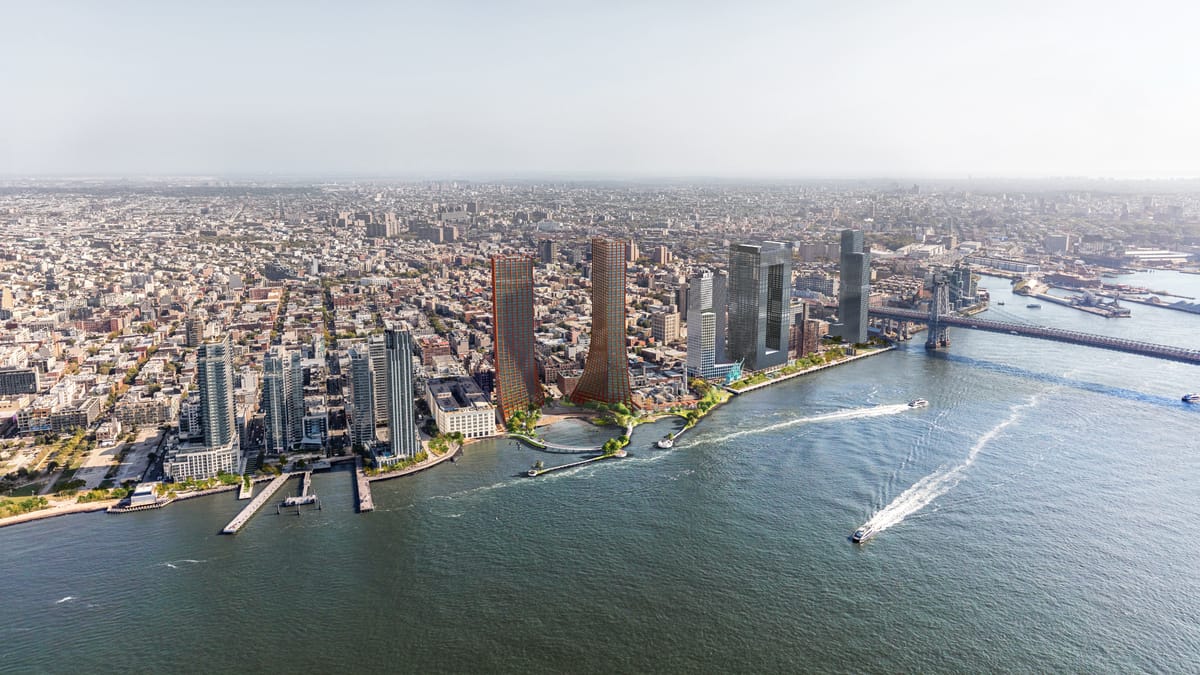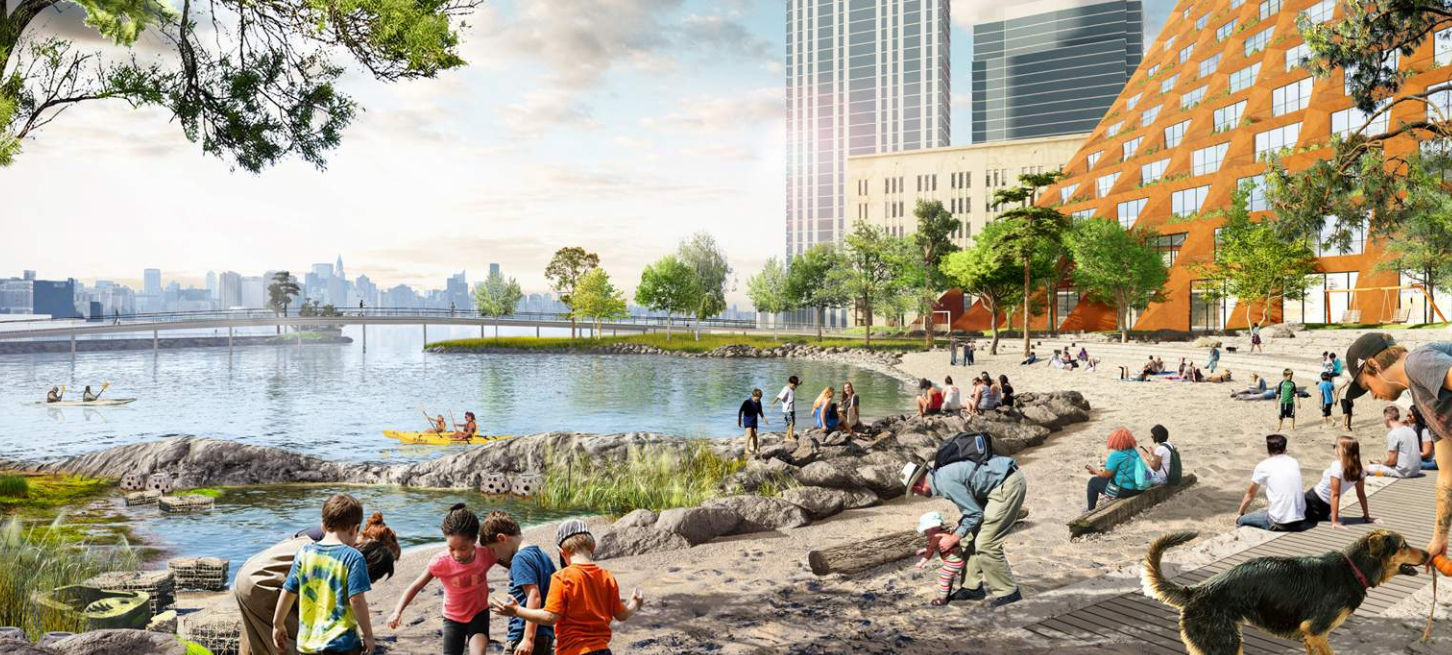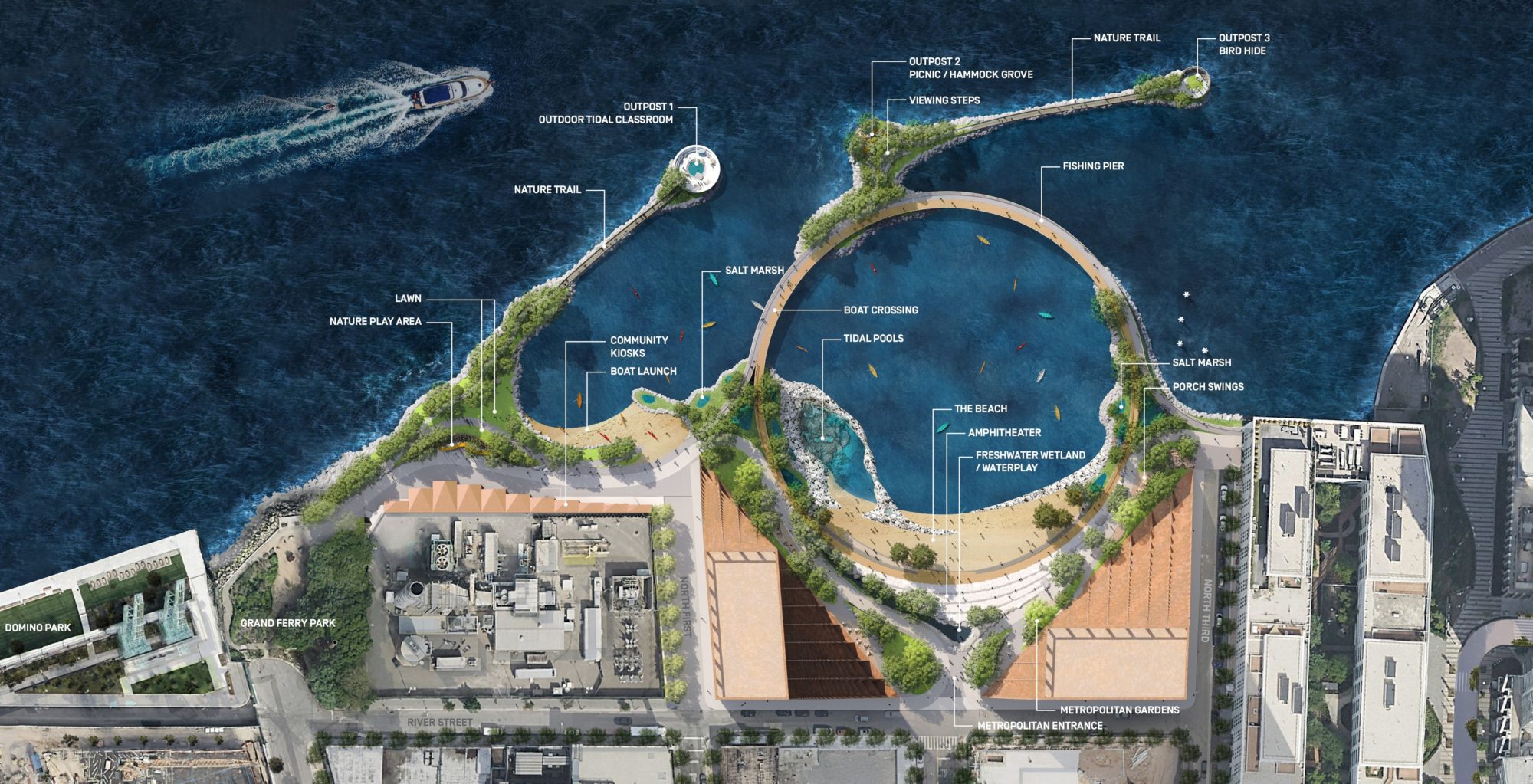Two Trees Meets with Neighbors to Discuss River Street Development


WILLIAMSBURG — On Monday evening developers from Two Trees Management met with concerned North Brooklyn community members about their new plan for the former Con Edison fuel oil storage complex site on River Street.
Two Trees, who is also developing the old Domino Sugar Factory site nearby, is expanding on the Williamsburg waterfront after the purchase of the Con Edison site for $150 million. The project includes two residential towers at 600 and 650 feet each, with 1,000 apartments, and a public park and a beach designed to interact with rising sea levels with a vision to change how New Yorkers “engage with the river.”
For the project to move forward, Two Trees must get approval to rezone the site for residential development. Dozens of community members showed up to the meeting, which filled Community Board 1’s district office to capacity.
Only 50 some people fit into the community board meeting, leaving another couple of dozen people outside. A community member vocalized the first concern, “How are you doing a presentation on a building with a thousand units in a room so small?”
Kevin LaCherra, a Greenpoint native who attended the meeting and spoke to Bklyner after, live-streamed the meeting for those who couldn’t get in via a North Brooklyn community group on Facebook. The community board representatives agreed to a second meeting next week on January 15 at the Swinging 60s center at 6 p.m. and will repeat the presentation.

The evening started off with a presentation from Two Trees, expanding on the park as a quiet, public green space, “their small footprint site, resulting in more height” of their two towers. The proposed development envisions ground-floor retail, a collaboration with the YMCA, and a community center, among other plans.
The community members echoed each other’s concerns after the presentation and asked Jed Walentas’, the CEO of Two Trees, questions:
Rezoning
Two Trees would like to have the property rezoned to an R8, allowing tall residential buildings. For many attendees, the very concept of a rezoning was worrisome. They were concerned about the aftermath of the 2005 rezoning that took place in Williamsburg and Greenpoint that brought lots of new construction, tourism, and traffic to the area, and is blamed for displacing longtime, largely minority working-class residents who could no longer afford the ever-increasing rents.
“Yes, it’s a brand new park, that is great, but it’s almost balanced out by the amount of people that would move into the building,” Kevin LaCherra, a Greenpoint native told us after the meeting. “This is his [Jed Walentas’] business, he’s asking the neighborhood for a rezoning, this area has suffered after the 2005 rezoning and people have concerns, and now we’re gonna go bigger and higher, and people are rightfully upset, these amenities are for who? As long as you can afford to live there?”
“The income distribution has changed in the neighborhood to a very large extent,” said an older neighbor at the meeting. “Those [River Street Towers] are not places where people are going to raise a family. People come from other parts of the country and move into these kinds of apartments, they work in Manhattan for three years, five years, seven years, make as much money as they can, and then they leave.”
He also added that a lot of commercial space is now empty, as the general income expectation is very high, and the new people moving in are raising that level, leaving longtime residents and businesses at odds.
Walentas responded by saying in his business focuses on renewals and understands the neighborhood is in transition that comes with a certain degree of frustration and will be honest with how they run their business in “our little part of your world.”
“While the park space added does look nice on paper, it is not that large and would be overrun quickly by tourists, others outside the community, and the 2-3,000 new people in those towers,” another concerned community member told us.

The Looming Towers
The proposed towers are set to be 600 and 650 feet tall, which is far taller than anything permitted in that area to date and will be North Brooklyn’s tallest buildings housing 1,000 apartments, 250 of which would be affordable housing.
Resident’s concerns about the height during the meeting were met with Walentas saying “The density is the same, and it’s my firm belief … that once you’re building to a certain height and having the footprints of the building smaller, and having thinner, taller, buildings is a tremendous benefit to the communities they surround: they block less views, have less shadows, and are far less impactful. You can disagree with me and think that height is the worst thing in the world.”
“With retail on the first few floors, it’s unprecedented and unnecessary,” Victoria Cambranes told us after the meeting. Cambranes was born and raised in Greenpoint and is running for City Council in 2021.
“I see no public benefit to the local community. Just more transient housing for wealthier people who come for 2-5 years and leave with no investment back into the community,” a concerned resident, who has been in the neighborhood for 11 years, told us after the meeting.
“You would have to make $97,000 a year to get an ‘affordable’ apartment,” said LaCherra with despair, referring to how luxury developments often have high Area Median Income (AMI) of 165%, making the units unaffordable to middle- and lower-class families. “It seems to me that the state and city should solve this, they are the ones who did the rezoning and left the communities lying in debris, and then we have to sit with the developers and figure it out.”
At the meeting, Walentas said affordable rents have yet to be determined for the new development and rely on many factors from city planning to the community board meetings. Nearby at 325 Kent at the Domino project, affordable housing ranges from $21,000 in annual income for one person to $54,000 in annual income for a family of four, with studio rents starting at $596 a month and two-bedrooms with $979 a month.
Transportation
“If you take the L train, like everyone else does, between the hours of 7 and 10, it’s bumper to bumper,” said Rod, a neighbor said at the community meeting. “That’s a thousand units, probably 2 to 3 people per unit, kids, whatever — how are these people going to get to Manhattan? Because that’s where the jobs are, that is where they’re working, how are they going to get back?”
He continued to elaborate the traffic on Kent and Wythe Avenues has gotten worse, and the L train won’t handle the additional residents, and another resident added that it will worsen with the completion of the Domino tower.
“Good city planning will try to promote and perpetuate more commercial activity in the neighborhood to balance that out,” Walentas answered. “All of us should work as a community over the next couple of decades to try and perpetuate more office and commercial activity in these neighborhoods, so they’re not just housing.”
“You can spend 25 minutes on Kent Avenue just dropping my kid off to school,” said another resident of the area. “You kind of smirk, and you joke … You don’t know the community, you don’t live here … The frustration we experience on a daily basis — you’re not going to solve any of that with this, you’re just going to add to it.”

Who’s Paying for It?
Some residents were concerned with the proposed development relying on getting a property tax abatement.
“So our pockets, our taxpayer pockets are being dipped into because we are not getting the property taxes for our firemen, our police officers, our schools, and everything else in this neighborhood, but supports these kinds of projects,” Cambranes said at the meeting.
Walentas answered the statements briefly, “I will put the integrity of myself and our organization up against anyone in this room and anyone in this city.”
“The public doesn’t need this developer or unprecedented development, it’s our subsidies and lives that are being affected,” Cambranes told us after the meeting.
Neighbors Felt Unheard
“I think what Two Trees is talking about, basically, is collateral damage. They’re really not too concerned whether the L is going to be busy, they’re really not too concerned whether you’re going to lose the [YMCA] in Greenpoint, they’re really not too concerned about the transient population they’re going to keep forming,” said a resident of the waterfront right next to the proposed development during the meeting. “Because all they care about is the bottom dollar, which is the profits that they’re going to make.”
“These questions are going to be raised over and over again by the community, and I don’t know if it’s helpful for you [Walentas] to use words like ‘infinitesimal,’ or to imply, or to out right say that these concerns are minimal compared to what you think the advantages will be,” said the community board member Del Teague at the end of the discussion. “I am pleased to see that so many people showed up tonight.”
Two Trees Promises Commitment
In a statement, Two Trees told Bklyner:
“Two Trees is fully committed to listening to what the community wants to see at this site and engaging in a deep and ongoing dialogue to ensure that what is developed maximizes benefits to local residents. We started that process last year with a series of listening sessions regarding the waterfront open space and see a unique opportunity to build on the success of Domino Park by creating a continuous North Brooklyn public waterfront and introducing a vital new approach to resiliency.
“We know that the significant development we’re proposing, in addition to delivering 250 units of affordable housing at low AMI bands, will have impacts that we are committed to minimizing while providing very significant community benefits.”
This story has been revised on January 9, after a draft was published prematurely.




